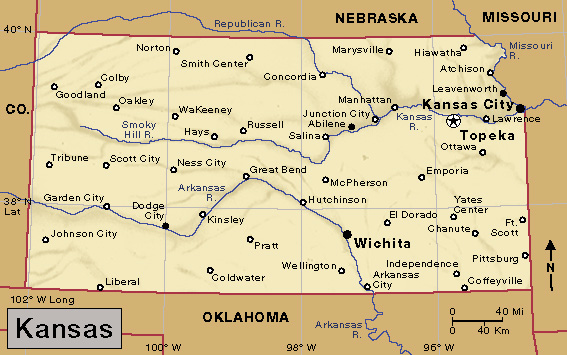Kansas City, Kansas (pop. 156,607), is an industrial city in the northeast corner of the state. The city lies on the Kansas-Missouri border, along both banks of the Kansas River, just west of Kansas City, Missouri.

Kansas City is the third largest city in Kansas. Only Wichita and Overland Park are bigger. Kansas City forms part of the important industrial center known as Greater Kansas City. It is part of the Kansas City, Missouri, metropolitan area, which has a population of 2,192,035.
Description.
Kansas City, the seat of Wyandotte County, covers 128 square miles (332 square kilometers) of rolling, hilly country. The downtown area includes courthouses and city government buildings. Wyandot National Burying Ground, also known as Huron Indian Cemetery, dates from 1843 and has been preserved in the downtown area. The University of Kansas Medical Center is also in the city. The National Agricultural Center and Hall of Fame lies just west of the city.
Economy.
Kansas City is the chief industrial center of eastern Kansas. Major industries produce automobiles, fiberglass, and soap. Kansas City is also an agricultural center of the plains region of the United States. Grain elevators in the city store great quantities of wheat. Major employers in Kansas City include the University of Kansas Medical Center and General Motors Corporation.
Several railroad freight lines serve the city. Railroad passengers use an Amtrak terminal in Kansas City, Missouri. The Kansas City (Missouri) International Airport and the Charles B. Wheeler Downtown Airport in Kansas City, Missouri, serve the metropolitan area.
Government and history.
Kansas City and Wyandotte County are governed by the Unified Government of Wyandotte County/Kansas City, Kansas. Voters elect a mayor and 10 commissioners to four-year terms. The mayor appoints a county administrator.
Before European Americans arrived, the Indigenous (native) Kansa people lived in the area that is now Kansas City. In 1804, the expedition led by Meriwether Lewis and William Clark camped there. In 1818, the United States government made the surrounding area a reservation for the Delaware (Lenape) people.
The Wyandot, a tribe from Ohio, purchased the land from the Delaware in 1843. They laid out a community and named it Wyandot City. They built the first free school in Kansas, a church, a community store, and a council house. In the 1850’s, white settlers began to move to the city. They soon outnumbered the Wyandot.
The settlers renamed the community Wyandotte. In 1859, a convention in Wyandotte wrote the Constitution under which Kansas gained statehood.
The citizens of Wyandotte played an important part in the antislavery movement. Some Black Americans settled there after the Civil War ended in 1865. A meat-packing company opened there in 1868. Many European immigrants came to Wyandotte as the meat-packing industry thrived. By 1880, Wyandotte had a population of 3,200.
Other communities grew up around the packing houses. In 1886, Armourdale and Kansas City combined with Wyandotte under the name of Kansas City. Two more towns, Argentine and Rosedale, later became part of Kansas City. In 1900, Kansas City had a population of more than 50,000. The city pioneered in the development of industrial parks by locating industrial plants in open areas away from residential sections.
The first urban renewal program in Kansas started in Kansas City in the late 1950’s. It included 11 projects, all completed by 1980. In 1987, General Motors completed a $1-billion automobile assembly plant to replace an existing plant. In 2001, the Kansas Speedway opened in the western part of the city. The speedway hosts stock car races. Children’s Mercy Park, the home of Sporting KC of Major League Soccer, opened near the speedway in 2011.
